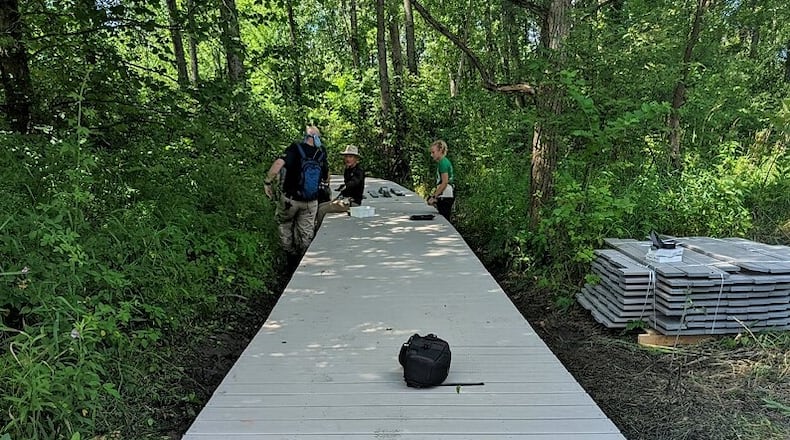Cost estimates for phase two of the project were previously around $1.8 million, however partnerships with other Ohio businesses have dropped that to around $1.2 million, according to Beaver Creek Wetlands Association executive director Jacki Mayer.
The nonprofit also hired outside construction for the foundations, which use pressure-treated lumber, but said the contractors have had no supply chain issues as it concerns the trail project.
“We were really lucky,” Mayer said.
The composite board used in constructing the trails is manufactured by TimberTech and supplied by Loveland-based McCabe Lumber, who offered a discount to the organization, and bought the materials after the first bubble in the lumber market popped at the end of last year.
Composite board typically runs more expensive than standard lumber, but highly volatile lumber costs means the gap between the two has thinned. Two massive bubbles in the market popped in 2021 and 2022, as futures fell from a high of $1481 per 1,000 feet in May to $471 in August 2021.
The Phase Two boardwalk, while making the reserve more accessible to the community, is also designed to be more accessible to those with disabilities. The boardwalk is ADA compliant and approximately five feet wide, Mayer said.
The Beaver Creek Wetlands Association, along with city and county parks departments and organizations like BW Greenway have long been preserving and protecting local fens, prairies, and marshes, and have sought ways to make those ecosystems more accessible to the public.
“We’re not slowing down,” Mayer said. “It’s pretty exciting how quickly this is moving along.”
When completed, the $7.5 million Spotted Turtle Trail will connect Zimmerman Prairie State Nature Preserve in Beavercreek with Pearl’s Fen, north of Fairborn, to provide 15 miles of wetland hiking trails. The five-year project will create an extensive system of trails through multiple wetland ecosystems, boardwalks, pedestrian bridges and overlook platforms which will give visitors access to Greene County wildlife that was previously inaccessible.
“It’s a draw for the this part of Greene County. It gives people just one more reason to come this way,” Mayer said. “If nothing else, what the pandemic really taught us is, we forget that we’re really fortunate to be surrounded by this incredible natural resource. I think it gave people a respite from the stress that we were all dealing with during the pandemic. And I think we just don’t take advantage of this as much as we should. And it doesn’t cost a dime.”
About the Author

